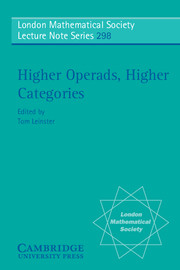Book contents
10 - Other definitions of weak n-category
Published online by Cambridge University Press: 08 January 2010
Summary
Zounds! I was never so bethump'd with words!
Shakespeare (1596)The definition of weak n-category studied in the previous chapter is, of course, just one of a host of proposed definitions. Ten of them were described in my (2001b) survey, all except one in formal, precise terms. However, the format of that paper did not allow for serious discussion of the interrelationships, and one might get the impression from it that the ten definitions embodied eight or so completely different approaches to the subject.
I hope to correct that impression here. Fundamentally, there seem to be only two approaches.
In the first, a weak n-category is regarded as a presheaf with structure. Usually ‘presheaf’ means n-globular set, and ‘structure’ means S-algebra structure for some monad S, often coming from a globular operad. The definition studied in the previous chapter is of this type.
In the second approach, a weak n-category is regarded as a presheaf with properties. There is no hope that a weak n-category could be defined as an n-globular set with properties, so the category Cn on which we are taking presheaves must be larger than Gn; presheaves on Cn must somehow have composition built in. The case n=1 makes this clear. In the first approach, a category is defined as a directed graph (presheaf on G1) with structure. In the second, a category cannot be defined a category as a presheaf-with-properties on G1, but it can be defined as a presheaf-with-properties on the larger category δ: this is the standard characterization of a category by its nerve (p. 116).
There are other descriptions of the difference between the two approaches.
- Type
- Chapter
- Information
- Higher Operads, Higher Categories , pp. 309 - 330Publisher: Cambridge University PressPrint publication year: 2004



